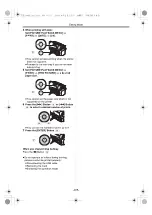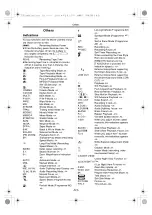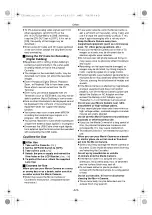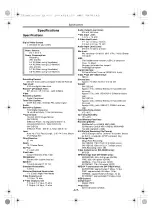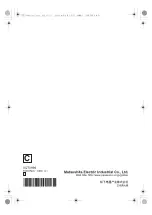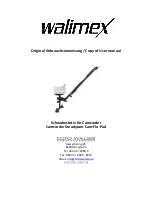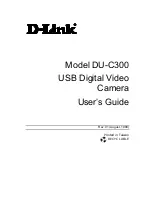
Others
-123-
≥
Before cleaning, detach the Battery or pull out
the AC Mains Lead from the AC mains socket.
≥
Wipe the Movie Camera with a soft dry cloth. To
remove stubborn stains, wipe with a cloth that is
soaked in a detergent diluted with water and
afterwards finish wiping with a dry cloth.
≥
For storing or transporting the Movie Camera,
place it in a bag or case lined with soft pads so
as to prevent the coating on the camera body
from being worn.
After use, be sure to take the Cassette out and
detach the Battery from the Movie Camera or
pull out the AC Mains Lead from AC mains
socket.
≥
If the Cassette is left in the Movie Camera, the
tape sags and deteriorates.
≥
If the Battery is left on the Movie Camera for a
long time, the voltage drops excessively, and
the Battery will not function even after it is
recharged.
ª
About AC Adaptor
≥
If the temperature of the Battery is extremely
high or extremely low, the [CHARGE] Lamp
may continue flashing, and the Battery may not
be charged. After the temperature of the Battery
has decreased or increased sufficiently,
charging starts automatically. If the [CHARGE]
Lamp continues to flash even after the Battery
temperature has decreased or increased
sufficiently, the Battery or AC Adaptor may be
faulty. In this case, please contact a dealer.
≥
If the Battery is warm, charging takes a longer
time than normal.
≥
If you use the AC Adaptor near a radio, radio
reception may be disturbed. Keep the AC
Adaptor 1 metre or more away from radio.
≥
When using the AC Adaptor, it may generate
whirring sounds. However, this is normal.
≥
After use, be sure to pull out the AC Mains Lead
from the AC mains socket. (If they are left
connected, a minute amount of current is
consumed.)
≥
Keep the electrodes of the AC Adaptor and
Battery always clean.
ª
Condensation
If you turn the Movie Camera on when
condensation occurs on the head or the tape,
Condensation Indication [
3
DEW] (yellow or red)
blinks on the Viewfinder or the LCD monitor and
the messages [DEW DETECT] or [EJECT TAPE]
(only when the tape is inserted) appear. In this
case, follow the procedure below.
Blink in yellow:
Dews are slightly adhering on the head or the
tape.
Blink in red:
Dews are adhere on the head or the tape.
1
Remove the tape if it is inserted.
≥
It takes about 20 seconds to open the
Cassette Holder. This is not a malfunction.
2
Leave the Movie Camera with the Cassette
Compartment Cover closed to cool or warm
it to the ambient temperature.
When [
3
DEW] blinks in yellow
≥
You cannot use the Tape Recording/
Playback Mode. Leave the Movie Camera
for about 30 minutes.
≥
However, you can use the Card Recording
Mode or Picture/MPEG4 Playback Mode
when the cassette is not inserted. (MPEG4
Playback Mode on NV-GS200 Model only)
When [
3
DEW] blinks in red
≥
The Power Indicator Lamp blinks for about
1 minute and then the Movie Camera
automatically turns off. Leave it for about
2 to 3 hours.
3
Turn the Movie Camera on again, set it to
the Tape Recording/Playback Mode and
then check if the condensation indication
disappears.
Especially in cold districts, dews may be frozen.
In this case, it may take more time before the
condensation indication disappears.
Watch for Condensation even before the
Condensation Indication is displayed.
≥
The condensation indication may not appear
depending on circumstances. When
condensation occurs on the lens or the Movie
Camera, it also may occur on the head and the
tape. Do not open the Cassette Compartment
Cover.
When the Lens is Fogged:
Set the [OFF/ON] Switch to [OFF] and leave the
Movie Camera in this condition for about 1 hour.
When the lens temperature becomes close to the
ambient temperature, the fogging disappears
naturally.
ª
Video Head Clogging and Care
If the heads (the parts that make contact with the
tape) are dirty, mosaic-pattern noise may appear
on the playback image, or the screen as a whole
becomes black. If the heads are extremely dirty,
recording performance deteriorates, and, in the
worst case, the Movie Camera cannot record at
all.
Causes of Dirty Heads
≥
Large quantity of dust in the air
≥
High-temperature and high-humidity
environment
≥
Damaged tape
≥
Long operating hours
120.200GC_eng.book 123 ページ 2004年2月25日 水曜日 午後5時38分

